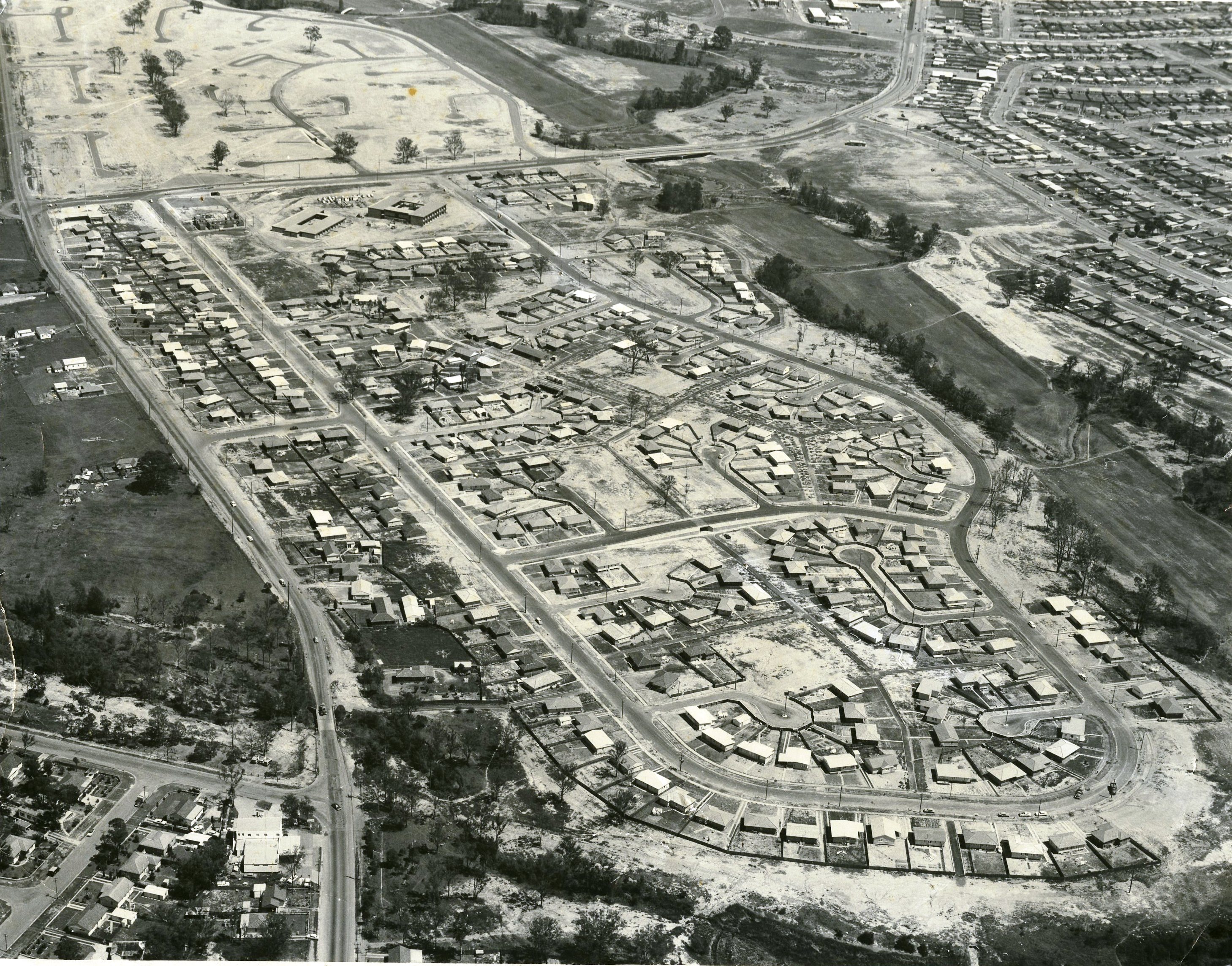The suburb of Cartwright was officially gazetted on 7 April 1972.Cartwright is one of the six suburbs of the Green Valley Housing Estate established between 1961-1965 by the NSW Housing Commission to provides homes for up to 30,000 people. The first sod was turned on the 3rd of August 1961. The suburb is bordered by Cabramatta Creek and Hoxton Park Rd.

Aerial photograph of Cartwright, Town Planning Department, 1966
Reverend Robert Cartwright (1771- 1856)
The suburb is named after Reverend Robert Cartwright, the first rector at St Luke’s Church, Liverpool.
Cartwright arrived in Australia in 1810 and was originally appointed to the Hawkesbury district. In 1819 he was appointed to Liverpool and he remained Rector there until 1836. Between 1825-1829 he was a teacher at the Male Orphan School, an orphanage established by Governor Macquarie in 1818, where destitute boys were housed and educated until they turned 15.
When Cartwright first came to Liverpool, he resided in the rectory at the corner of Elizabeth and Macquarie Streets, where Westfield shopping centre now stands. He later moved to his farm named Maryvale, thought to be located on part of the site of present-day Cartwright.
Maria Lock
Maria Lock was an Aboriginal woman who defied Church and Government.
The marriage of Maria and Robert Lock in 1824 was the colony’s first marriage between an Aboriginal woman and a white man.
Maria, the daughter of Yarranundi, was born near today’s Richmond c1808. In 1814, she was the first child placed in the Native Institution. She may be the child who carried off the top academic prize in 1819, against 100 European and 20 other Aboriginal children.
She met Robert Lock when he was working as a convict carpenter at the Native Institution. He had been transported for 7 years for theft but was said to be an honest and hard-working man. They married in 1824; she was 16 and he was 24. They were given four acres at Blacktown.
In 1825, they moved to the Reverend Cartwright’s farm at Liverpool where Robert worked for Cartwright. In 1831, Maria petitioned Governor Darling for a small grant of land and a cow. She had been promised these when she married but still had not received them. Darling directed the Locks to select 30 acres near where they currently lived; they selected land next to Cartwright’s farm.
But Robert Cartwright, whom Maria had once called her best and only friend, also wanted this land. The Locks were told to select another block of land, but Maria refused to give up without a fight. She appealed to the new Governor, Bourke, who took her side. They finally attained the land in 1832, despite Cartwright’s objections.
It may be where the Liverpool City Council now stands.
Maria also owned 60 acres in Blacktown, and the family moved there in 1843 or 1844. They had 10 children. Robert died in 1854, Maria in 1878. Her land was divided among her nine surviving children.
The Myth of Maria Lock
Maria Lock has long been remembered as a perfect example of colonial assimilation. She could read, write, married a white man, acquired land and raised a large family.
But is this really what occurred?
Maria’s life story does not match this essentialist narrative. Maria did not ‘reject’ her Aboriginal background. She managed to negotiate a middle ground.
Her intellect and adaptability allowed her to operate according to the expectations of settler society. However, she always maintained an Aboriginal sensibility and commitment to place and family.
Her marriage to Robert Lock suggests that she chose a life more like that of white people, but she always wanted to return to her own country. She used settler systems, pen and ink, to bring her family back to Blacktown.
Pictorial History: Liverpool & District by Carol Liston (2009), p. 115
Cable, K. J. “Cartwright, Robert (1771–1856).” In Australian Dictionary of Biography. Canberra: National Centre of Biography, Australian National University. Accessed March 16, 2022. https://adb.anu.edu.au/biography/cartwright-robert-1882
GEOGRAPHICAL NAMES ACT, 1966 (1972, April 7). Government Gazette of the State of New South Wales (Sydney, NSW : 1901 - 2001), p. 1199. Retrieved May 25, 2021, from http://nla.gov.au/nla.news-article220139777
See something missing?
You know your suburb better than anyone. If you think an important part of your suburb’s history is missing, whether recent or distant, reach out to the Local Studies Team through our online Local and Family History enquiry form. We are always looking for new ways to bring the vibrant history of Liverpool to life!
